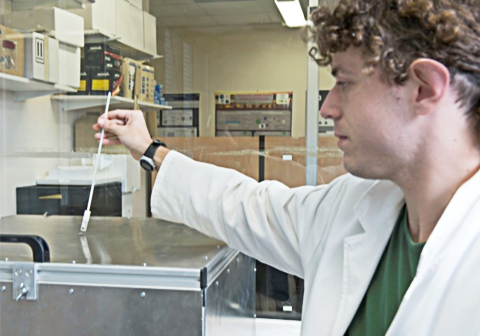Hyperthermia (increase in body temperature) has been used for centuries to combat tumours and reduce their effects. The aim of the research by the physicist Eneko Garaio is hyperthermia but using a different system (magnetic nanoparticles) to increase body temperature. These nanoparticles absorb energy from magnetic fields and convert it into heat which is used to raise the temperature in tumours and combat them. It just so happens that a paper on this subject by Garaio and other authors and published in 2014 in the journal Measurement Science and Technology has recently received the Outstanding Paper Award.
Magnetic hyperthermia, an auxiliary tool in cancer treatments
A researcher of the UPV/EHU-University of the Basque Country is using magnetic nanoparticles to produce heat and be used against tumour cells
First publication date: 26/06/2015

Back in the 1990s the discovery was made that under the action of alternating magnetic fields, magnetic nanoparticles absorbed a large quantity of energy. Out of that discovery emerged magnetic hyperthermia, an experimental therapy against cancer in which magnetic particles strategically placed in the tumours are turned into a heat source. Nanoparticles emit the energy they absorb from the alternating magnetic field as heat which is applied to them externally causing the temperature in the tumours to rise.
According to Garaio, this system offers various advantages: "Firstly, the magnetic fields used are not harmful for the body, in other words, they produce no heat so they do not affect the healthy parts of the body. Secondly, nanoparticles can be surrounded by ligands. The particles tend to be iron oxide while the ligand is made up of a layer produced by means of organic molecules. This system enables the nanoparticles to stick to the tumour cells without affecting the healthy cells".
There are various methods of raising the temperature and hyperthermia treatments are classified on the basis of them. In radiofrequency hyperthermia, for example, electric currents induced by electromagnetic waves are used to raise the temperature of tumours, and antennas to concentrate the heat in the tumours. The placing of these antennas beside the tumours is done by means of surgery. In ultrasound hyperthermia, the heating is carried out by means of vibrations; in laser hyperthermia, by contrast, infrared laser is used to excite gold or silver nanoparticles placed beside the tumours to heat the tumour cells.
Hyperthermia, an old technique with new applications
According to Garaio, the most important result of his research is this: "We manufactured a tool to measure the specific nanoparticle absorption rate; we then built various models to calculate the specific absorption rate and to find out how the shape, material and ligands of the nanoparticles change". As regards lab tests, "we induced necrosis in the livers of three mice without causing any damage to the healthy cells of these organs," pointed out the researcher.
Doctors were aware of the effectiveness of heat to combat tumours over a thousand years ago, and about 200 years ago they induced fever in their patients so that the heat would combat the tumours. "Basically, that is what hyperthermia is," explained Garaio. "But the heat mustn't be administered in just any part of the body nor in just any way. It must only be applied to the tumours at a temperature ranging between 41 and 46 °C. That is the temperature range in which magnetic hyperthermia is the most effective," said the author of the thesis.
Additional information
Eneko Garaio-Urabaien (Iruñea-Pamplona, 1985) is a graduate in Physics and a researcher recruited by the UPV/EHU, where he carried out most of the work for his thesis (Development of Experimental Techniques for Magnetic Hyperthermia Therapy). His PhD thesis was supervised by Fernando Plazaola, the deputy dean of research at the UPV/EHU, and Professor Jose Angel García.
Bibliographical references
E. Garaio, J.M. Collantes, F. Plazaola, J.A. García, I. Castellanos-Rubio. ‘A multifrequency eletromagnetic applicator with an integrated AC magnetometer for magnetic hyperthermia experiments', Measurement Science and Technology, 2014. This paper has recently received the Outstanding Paper Award given by the journal Measurement Science and Technology.
H. Khurshid, J. Alonso, V. Sankar, Z. Nemati, M.H. Phan, H. Srikanth, E. Garayo, J.A. Garcia, ‘FeCo nanowires with enhanced heating powers and controllable dimensions for magnetic hyperthermia', Journal of Applied Physics, 2015.
E. Garaio, O. Sandre, J. M. Collantes, J. A. Garcia, S. Mornet, and F. Plazaola, ‘Specific absorption rate dependence on temperature in magnetic field hyperthermia measured by dynamic hysteresis losses (AC Magnetometry)', Nanotechnology, vol. 26, p. 015704.2015.
Photo: Elhuyar

